
In the previous article, Book Condition Ratings Explained & Compared, we’ve covered all the essentials regarding how the book condition rating system works and how different marketplaces grade used books they sell. Today, we’ll give you a few hands-on recommendations regarding the process of determining book conditions. While most book resellers know all about it from personal experience, we’re positive some beginning book resellers will find our article helpful.
- Book Condition Rating Systems
- How to Inspect Books—Tips to Determine Your Book Condition
- Book Conditioning FAQs
Book Condition Rating Systems
Before we get all practical, let’s revise what we already know.
First of all, before we get all practical, we suggest you go through our previous article, Book Condition Ratings Explained & Compared, and recall what we already discussed about book condition ratings. As you now know, most booksellers rate used books on the range from Used – Like New to Unacceptable; however, different marketplaces choose different grading scales.
For your convenience, we’re sharing the comparison table we compiled in the previous article once again:
|
Comparative |
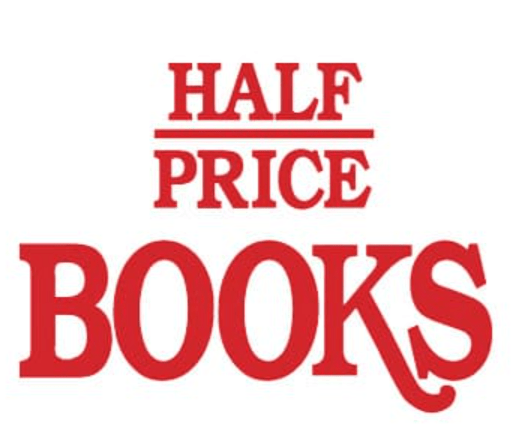 |
 |
||||
|
5/5—New, As New |
New |
Brand new |
As New |
New |
Fine |
New |
|
4/5—Fine, Very Good |
Used |
Like new |
Fine (F or FN) |
Fine |
Near Fine (NF) |
Very good |
|
3/5—Good |
Used |
Good |
Good (G) |
Good (G) |
Good (G) |
Good |
|
2/5—Acceptable |
Used |
Acceptable |
Fair |
Fair (F) |
Fair (FR) |
– |
|
1/5—Everything else |
Unacceptable |
– |
Poor |
Poor (P) |
Poor (P) |
– |
We’ve compiled this table with book condition ratings from several bookselling marketplaces to illustrate our attempt to unify these different approaches into a 1 to 5 scale. So when you sell books on several platforms (which you probably do), you can use it as a reference when apprising your books.
Secondly, we suggest you learn as much as possible about each of your bookselling channels (especially if you’re just getting started). For instance, if you sell most of your inventory on Amazon, you need to know how to grade books so that they pass Amazon checks without any problems. Amazon outlines its book condition guidelines and textbook guidelines quite clearly, so it’s not the purpose of this article to repeat this information; you can go through it yourself. Besides, you should also understand which of your other sales channels have any specific requirements (or peculiarities) that you should take into consideration. As a matter of fact, eBay’s grade to determine the condition of books is a bit different from Amazon’s, so you have to understand how to determine the book’s condition for each platform separately. The same book can be listed as Very good or Good depending on the market.
How to Inspect Books—Tips to Determine Your Book Condition
We’ll cover the basics: steps you must take and things you must do when you grade your books. Now that you know the different book condition descriptions, let’s see how we approach each book (with examples).
Be Thorough
As 90% of your book inventory is probably used books, you should learn to examine them fast, thoroughly, and efficiently. Being too perfectionist won’t take you far; being too hasty and inattentive in your inspections will lead to negative reviews and all sorts of problems. So, make sure you do it fast but properly.
Primary Examination: Item Check
While the aim of the article is to tell you how to determine book conditions, we suppose it won’t hurt to remind you about the necessity to check and confirm the book’s ISBN to match the product on the marketplace. Also, check the following thing that should match: hardcover/paperback (surprising as it is, the book in your hands may be a hardcover, but a listing on Amazon may display it as a paperback for some reason). Also, check whether it’s an instructor’s edition/a complimentary copy/an exam copy/a preliminary edition/etc. Keep in mind that if your textbook is an international edition, you can’t sell it as a US edition.
Secondary Examination: Determining Condition
Inspect the core parts of the book thoroughly:
- Dust jacket/Cover
- Corners
- Pages
- Spine
For instance, you have a copy of How to Read Bridges: A Crash Course Spanning the Centuries. It’s in pretty good condition, with a good cover, no scratches, no signs of damage, clean edges and spine, and all of the book’s pages are in perfect order. Yet it doesn’t have the look and feel of a pristinely new book; you can see it was opened and read. The previous owner treated it with love and care, but we recommend listing it as Very Good or Good.
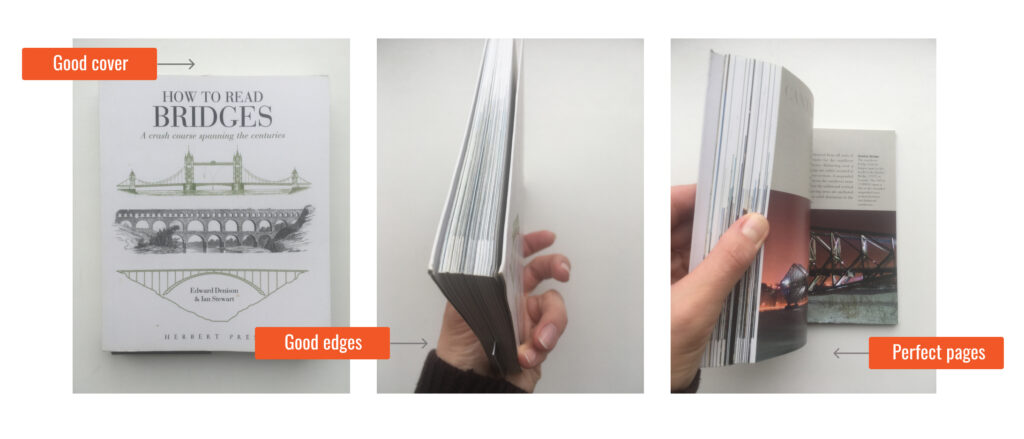
| We recommend spending extra time inspecting the book you want to list as Like New / As New / Fine. You should make sure it looks exactly as if it’s come straight from the publisher. Look at your book; is it really this new? |
Here’s what you should pay attention to when you sort your books in separate piles according to their state:
- The book has/doesn’t have an original protective wrapping. If a book is in its original wrapping and isn’t damaged in any way, you can list it as New. If not, downgrade it to Like New or else.
- The book is in the original dust jacket. / Dust jacket is missing. Check if it’s in ideal/good/fair/poor condition. Some books can have good pages but obvious signs of tear and wear on the dust jacket. These books most likely can only be listed as Acceptable.

- The spine is clear of any damage. / Minor damages are present. / Etc. Check the spine for signs of damage, tear, and wear. We’ve added a few examples of spines with different degrees of damage. The first book is a bit torn, so you can’t list it as Good; the rest can more or less pass as Good or Fair:

- No signs of wear. / There’re some signs of wear/heavy wear/etc.In the first example below, the book has badly torn edges; other books also have minor scratches and bumped corners, which inevitably downgrades them to lower condition categories.

- No damage to the edges. / Edges have minor signs of damage/scratches/etc. The state of the edges also affects how the book is conditioned. While the book may look more or less ok overall, various scratches, dents, stains, etc. on the edges inevitably send it to the Good (or even Acceptable) pile.
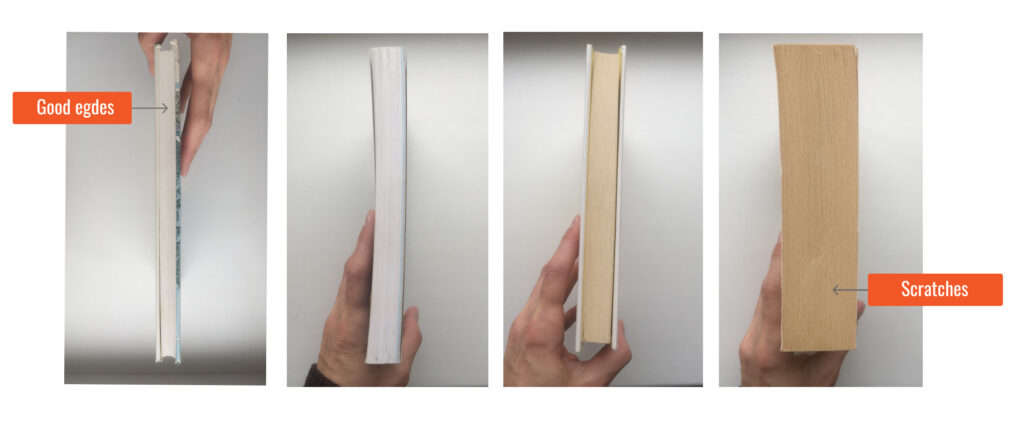
- No damage to the pages. / Pages have folds/smudges/tears/etc. In the example below, you can see a few very yellowed (and sunned) books. While the pages look alright, these books can be graded as Fine or Acceptable, depending on the marketplace.

- No highlights, markings, underlines, etc. / Some or many highlights, markings, underlines, etc. This is an important part: it may be hard to sell books with library stamps, heavily highlighted books, books with stickers, etc., at some marketplaces. Besides, former library books with stickers and markings will automatically send your book to a Good pile (at the very best). So it makes sense to inspect each book you want to list carefully. Always make sure to mention these facts in the description because customers do care. After all, you don’t want bad reviews, do you?

- No dust. / Dust or grease on pages, cover, etc. Check the book for signs of dirt, dust, grease, stains, etc. Such books won’t sell well. After all, who wants a book—even if it’s used and cheap—that was obviously used as a food tray and not as a book? Exactly, no one.
- No water damage. / Signs of water damage. It’s obvious: books that bear marks of contact with water will most likely go to the Acceptable pile at the very best.
- No manufactural misprints. / Any misprints/etc. Such things also happen, and while they’re not your fault, you’d better be aware of them before your customers tell you about them.
Conditioning Old and Rare Books
While it’s not the purpose of this article to outline the rules of determining book conditions for rare books and collectibles, you can use our tips if you come across an old book you want to sell. So here’s what you do: take a good look at the book’s overall appearance and pay attention to the same things we’ve already discussed. Let’s use the copy of The Dramatic Works Of William Shakespeare (1839 edition, published by John Child and Son printed for Thomas Tegg) as an example.

You can see that the book is bound in leather, with quite a bit of wear and rubbing and a few scratches along the cover and age-related paper toning but internally very good. It’s also a signed copy with fore-edge painting (though no cover art), so you should take these things into consideration as well. All in all, it seems to be in pretty good condition, and judging by the condition of the pages, it may have never been read, so on Amazon’s grading scale, it can pass either as Collectible – Very Good or Collectible – Good. 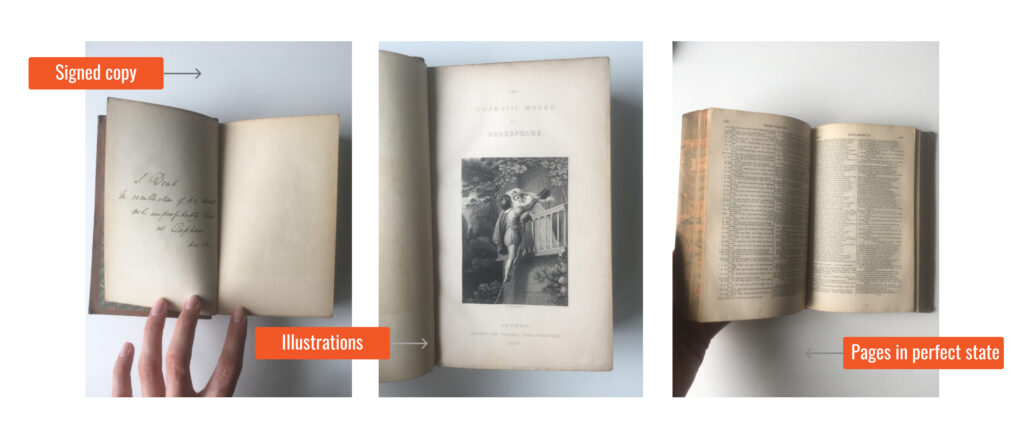
Working with books that are more than a hundred years old is exciting. Yet, it’s an entirely separate bookselling niche that requires specific knowledge and experience. Perhaps, we’ll get back to this topic in more detail in one of our articles in the future, so stay tuned.
Be Objective in Your Evaluation
While listing some of your books as New may be tempting, you should be objective. Though you may have new items, most of your stock will be from the Like New category (and lower). We recommend sticking to the rule that you don’t overgrade your books. Take a look at another example: this copy of The Tower and the Bridge: The New Art of Structural Engineering has only a few dings to the cover; its pages and edges are all perfect. Yet again, it has a distinct air of a book that has been read at least once, so we should probably list it as Good:

Make sure you inspect your books as objectively as possible, and if there’re highlights or signs of slight damage, make sure you mention it and condition the book accordingly. In all situations, use common sense. Whether we’re talking about Amazon or any other bookselling marketplace, it’s the surest way to keep your account safe and sound. If, at first sight, a book has an ideal cover, look at the edges and pages, and check it for any things that shouldn’t be there (e.g., bookmarks, sticky notes, checks, dried flowers, you got it).
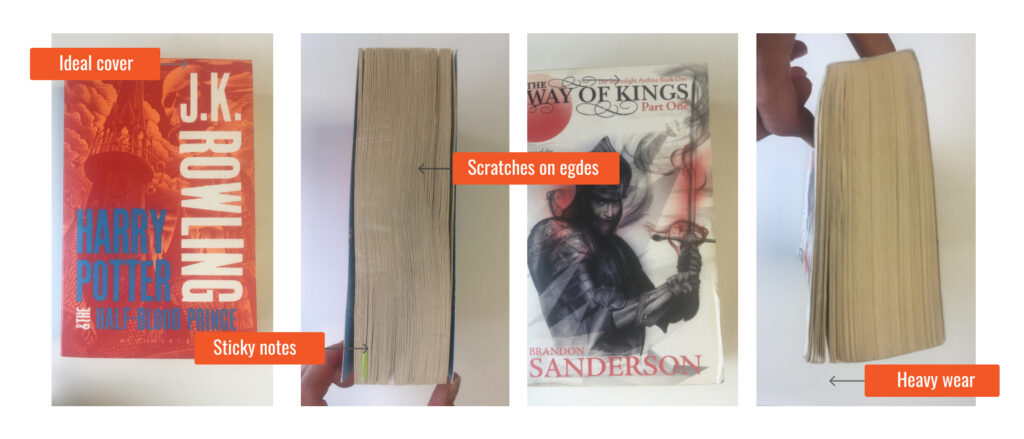
| Well, yes, we recommend downgrading your books a little. If you see that it has all the chances to pass as Like New, you can list it as Very Good. This strategy can help you get positive reviews (especially if you’re just starting a book reselling business). |
Here’s another example: this copy of Invisible Influence: The Hidden Forces that Shape Behavior had never been read since it was bought a few years ago. However, it no longer looks fresh (so it can be conditioned as Like New), which automatically makes it a Very Good listing candidate:
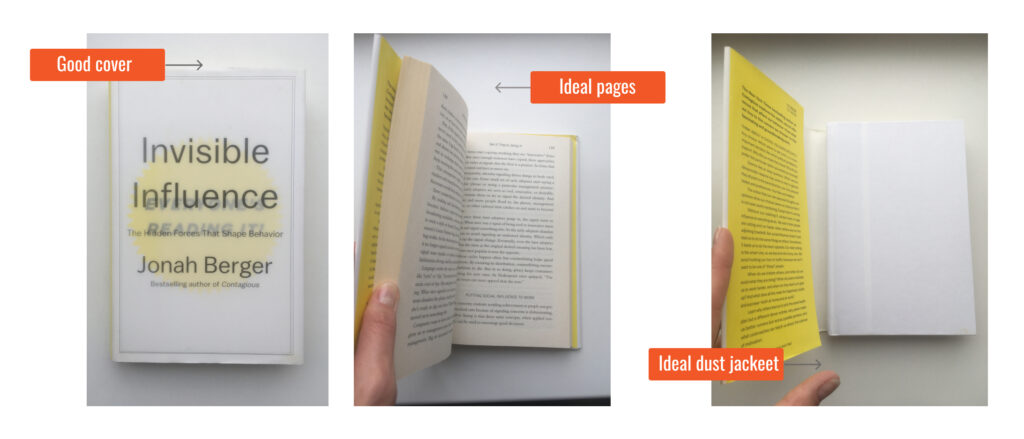
Be Careful with Books Yourself
You may easily be blamed for damages during shipping, even if it’s not your fault. Nonetheless, always be very careful when you inspect books. Why so? Being careful ensures that books stay in the best condition they can be listed. Always touch the books with clean hands to avoid smudges. Be careful turning the pages and examining the cover (especially in paperbacks) in order not to damage or tear anything. In other words, be very careful at every stage of inspection, all the way through packaging.
Book Conditioning FAQs
How Much Does Proper Book Conditioning Matter?
At BookScouter, we absolutely agree with the piece of advice from the video about How to Grade Books Condition | Sell Books on Amazon FBA Guidelines, which is all about underpromising and overdelivering.
As we’ve already said, stay objective in the process of book inspection and better choose to downgrade your books instead of overgrading them. Try looking at the book you want to sell from a customer’s point of view: how would you feel to receive a heavily worn book that was listed as Like New? Exactly. Stay objective; don’t overgrade. This will give you better results and more satisfied customers.
Should I Always Add Condition Notes to My Book Listings?
We’d say, unless your book is New, always do so. If there’s something a customer should know about (unless you want to make an unpleasant surprise to them), always add notes about any peculiarities of a book. Depending on the marketplace, you can do it manually; if you’re using a listing or inventory management system, the process may be a bit different but quite easy nonetheless.
Final Thoughts
So, to cap it all, we’d like to say that book conditions are important. Equally important is your accurate inspection of a book before sending it to a marketplace and objective grading. When assessing a book’s condition, check everything we’ve outlined earlier and always remember that even such minor issues as bends and creases can impact a book’s value. We hope our guide will be helpful to everyone who’s in a book reselling business. Good luck with your sales!




